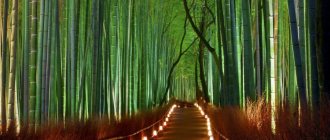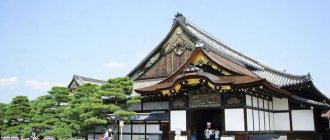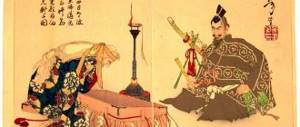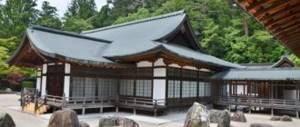The visiting card of the Japanese city of Kyoto is Kinkaku-ji. A magnificent architectural creation, the walls and roof of which are covered with thin gold plates. A copper figure of the Phoenix crowns the roof of the pavilion. The building has three tiers and is located between large and tiny islands. The Kinkaku-ji Golden Pavilion is a cultural and national treasure of Japan.
Panorama of Kinkaku-ji Temple
This golden structure is nestled on the shores of the fabulous “Mirror Lake”. Every year there are more and more people wanting to admire this splendor.
History of the Golden Pavilion
In 1394, the famous Japanese military leader Ashikaga built a magnificent golden palace in the vicinity of Kyoto. It is known that after his death this beautiful building became the property of the Buddhist monastery of Rokuonji.
During World War II, as a result of constant bombing, the pavilion could have disappeared if not for a letter from the Russian scientist Sergei Eliseev. In his message, Eliseev addressed the American General MacArthur. He asked to spare this magnificent architectural creation and not to bomb within Kyoto.
The Golden Pavilion was preserved. But in 1950 he was burned to death by a Buddhist monk in a fit of madness. Afterwards the pavilion was restored and updated. It was restored piece by piece. Currently, Kinkaku-ji is a repository of sacred relics.
Garden
The garden around the pavilion was made in a circular style. The building stands above the Kyoko-chi ("Mirror Pond") pond, which contains 10 small islands. A typical Zen composition of rocks, bridges and plants, which is designed to recreate famous places described in Chinese and Japanese literature. The garden was created according to the descriptions of the western paradise of the Amida Buddha, illustrating the harmony between heaven and earth. The largest island in the pond symbolizes the Japanese islands, and the four stones forming a straight line at the pavilion represent boats moored in the night at the mythological Chinese Island of Eternal Life.
What attracts tourists to Golden Kinkaku-ji?
The Golden Palace of Japan is often called Kinkaku-ji. It is made in a palace style, so it is different from all Japanese temples. The golden roof and walls of the pavilion sparkle in the sun and attract the attention of numerous visitors.
Panorama of the lake near Kinkaku-ji Temple
The lake, spread out in front of the pavilion, turns into a real mirror in calm weather. At this time, you can see the reflection of a beautiful golden palace in its waters. Numerous wild pine trees grow around the lake.
There is also a magnificent garden on the territory of Kinkaku-ji. Tourists can stroll along its winding paths and admire the numerous streams and small ponds. Numerous stones and pebbles are scattered throughout the garden. The diversity of the flora surprises and impresses visitors.
The first tier of Kinkaku-ji was built in a palace style. The Japanese call it the Water Purification Temple. Its veranda offers magnificent views of Mirror Lake. And inside the tier there are a large number of bright, spacious rooms. There is also a hall here that the great Ashikaga used to receive diplomats and conduct important business negotiations.
The second tier is made in the national Japanese style. Magnificent tea ceremonies were held here many years ago. And in the evenings, crowds of guests gathered, melodious music sounded, and poets read their new poems. The Japanese called this tier the Surf Grotto.
On the third floor of the pavilion there are rooms intended for various religious rituals. It began to be called “The Pinnacle of Beauty.”
My 100 roads
Today everything went according to plan and we visited four top attractions in the northern and northwestern areas of Kyoto. But everything is in order...
– Golden Pavilion – Kinkaku-ji (金閣寺) in the reflection of Kyoko-chi (鏡湖池) – “Mirror Lakes”
Part 3 – Kyoto – the soul of Japan
– Day fifteen – Temples and gardens
Golden Pavilion – Kinkaku-ji (金閣寺)
First morning in Kyoto. Saturday. We got up early to be at the bus stop near our hostel Nanajo Kawaramachi by 8 am (七条河原町)
.
Bus number 205
arrived just at 8:00.
After 45 minutes we arrived at the Kinkakuji-michi stop (Kinkakuji-michi / 金閣寺道)
, then walk a little or one stop by bus -
No. 12
or
No. 59
. We decided to walk.
Kinkaku-ji/金閣寺
opens at 9:00, but 10 minutes before opening there was already a rather large queue, and during these minutes it tripled. Some photographers with tripods were allowed in earlier, apparently by agreement, because when my husband wanted to take a few pictures with a tripod, the security guard insistently asked him to remove it. It turns out that you can do it without a tripod, but with it… ordinary people can’t.
Well, "Golden Pavilion"
impresses with its beauty. He attracts your gaze like a magnet and you look at him enchanted. However, this copy is from 1955, because that old one, built in 1397, was set on fire by a mentally unstable Buddhist novice.
On July 2, 1950, the Golden Pavilion was burned to the ground by the fanatical monk Hayashi Yoken. After setting the fire on the hill behind the building, he attempted suicide, but survived and was arrested. The monk was sentenced to 7 years in prison, but was released in 1955 due to mental illness, and died in 1956.
The beauty of this pavilion saved it for more than 5 and a half centuries, and it also became the reason for its death. The verdict stated that “the defendant hated everything beautiful and always felt an irresistible desire to destroy any manifestation of beauty.”
.
So why is he so handsome? Why were the creators of the original accused of being eclectic and not understanding the essence of Japanese culture?
Homes reflect the character and desires of their owners. “Let’s look” there. And so, all sorts of historical sources say that...
In 1394, the military ruler of Japan, the third shogun of the Ashikaga dynasty, Ashikaga Yoshimitsu (足利義満)
(1358-1408) unexpectedly abdicated power in favor of his eight-year-old son Yoshimochi, deciding to devote the rest of his days to comprehending the depths of Buddhist teachings and practicing the fine arts.
And before that, Ashikaga Yoshimitsu
received as a gift from the aristocratic family
Saionji (西園寺)
an estate in a wonderful place near
Kitayama (北山)
, near the Northern Mountain (or maybe they were made an offer that they could not refuse, things were a long time ago). There, three years after the “retirement” of Ashikaga Yoshimitsu, the construction of a new palace complex was completed. Let me remind you that this is the beginning of the Muromachi Period, when the Emperor of Japan has no actual power. The shogun has all the power, and Ashikaga Yoshimitsu just abandoned the post of shogun in favor of his young son, which means he is the regent, i.e. he has more freedom and almost unlimited power.
If you remember, in the last post I wrote that since 1188, the teachings of the “Pure Land” school, the doctrine of salvation and rebirth in the “Pure Land” through prayer to Amida Buddha, became popular in aristocratic circles. Those. belief in heaven. Well, the new palace complex is the embodiment of heaven on earth for an individual. It's simple.
According to the unanimous reviews of contemporaries (even those who are difficult to suspect of sympathizing with Yoshimitsu), the new palace in the Northern Mountains is Kitayamaden (北山殿)
– was great. The dense greenery of trees growing in clumps, ponds with large and small islands, exquisite pavilions and gazebos, beautiful views with silhouettes of distant mountains - all this made an indelible impression.
The palace complex consisted of buildings for various purposes: religious - the Tomb, the Temple of the Sacred Fire, the Hall of Repentance, the Temple of Purification by Water; secular buildings - the Main Palace, the House of Courtiers, the Meeting Hall, the Palace of the Heavenly Mirror, the Tower of the North Star, the Spring Palace, the Manor of Admiring Snow and other buildings. The largest amount of money was spent on the construction of the Tomb, which later became known as Kinkaku-ji.
-
“Golden Temple”
.
Even now the name of one building eclipses the name of the whole complex, then Kitamaden
is now
Rokuon-ji (鹿苑寺)
.
– Two golden floors of the pavilion
And if the “Golden Pavilion”
This very, very symbol of the city of Kyoto, then I will pay excessive attention to it. People are not allowed inside the pavilion itself, but sun-bleached pieces of paper hang nearby, giving a vague impression of the interior decoration of this building.
"Golden Pavilion"
consists of three floors with two tiers of roofs. The top two floors are covered with pure gold, which explains the name of the temple.
First floor
– is called
Hosuyin (Ho-sui-in/法水院)
–
“Water Purification Temple”
. It is designed in the style of aristocratic villas from the Heian era (traditional Japanese architectural style). It is surrounded by a terrace jutting out over the lake and was used by the ex-shogun as a hall for business negotiations with Chinese ambassadors of that era.
Second floor
resembles a samurai’s dwelling and is called
Toonhora (Shio-on hora / 潮音洞)
-
“Surf Grotto”
. It was used as a poetry and music hall, tea ceremonies were held here, musical performances and poetry evenings were organized.
Third floor
- This is the cell of a Zen Buddhist monk.
Its name is no less romantic - Kukkyo-cho (Kukkyo-cho / 究竟町 / 究竟頂)
-
.
” It is separated from the first two by a tier of roof and consists of only one room, which is decorated inside and outside with sheets of gold. This room, decorated with Buddha statues and an altar, had a religious purpose and was used as a prayer house. On the roof of the temple there is a bronze phoenix Ho-o (鳳凰)
- a symbol of happiness.
– Phoenix on the roof of the pavilion
The pavilion surrounds the Kyoko-chi garden and pond (Kyoko-chi/鏡湖池)
-
“Mirror Lake”
.
A pond with picturesque islands and stones of bizarre shapes and colors, which, without limiting their means, were sought in distant provinces and presented to the powerful shogun Ashikaga Yoshimitsu by his vassals. Most of the islands have poetic names - Ashihara-jima / 葦原島
(Ashiwara - “Land of Reed Plains” - that’s how Japan was called in ancient times) with a large decorative stone on it
Hosokawa-ishi (細川石)
.
From the veranda of the pavilion, two main islands are clearly visible - “Turtle Island” (Kame-jima/亀島)
and
“Crane Island” (Tsuru-jima/鶴島)
, which symbolize longevity. The islands and stones are arranged in such a way that they seem to frame the reflection of Kinkakuji in the lake, which only emphasizes its exquisite severity.
– Island and crane in Kyoko-chi pond (Kyoko-chi/鏡湖池)
Its current name is Rokuon-ji (鹿苑寺)
which means
“Temple of the Deer Garden”
, the temple received after the death of Ashikaga Yoshimitsu, because. his posthumous name is Rokuoniin (鹿苑院), then... you understand




